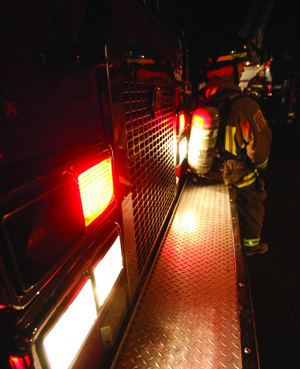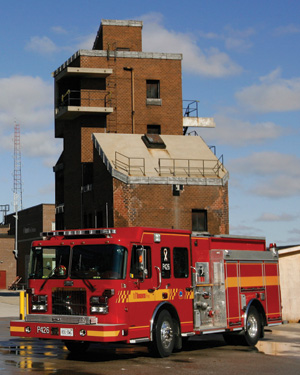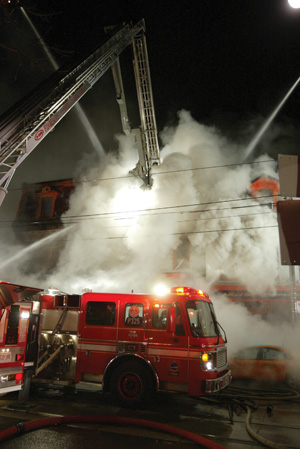
Equipment
Apparatus Issues
Aging apparatus and the lack of funding to replace it is a major topic of conversation among fire chiefs at provincial association meetings and other conferences. With the 2009 edition of the NFAP’s 1901 Standard for Automotive Fire Apparatus to be applied to all new orders effective Jan. 1, we talked to Canadian apparatus manufacturers about the challenges the fire fighting industry faces.
November 17, 2008
By James Careless
 |
Canadian manufacturers lament poor market, lack of funding to keep equipment up to standards
Aging apparatus and the lack of funding to replace it is a major topic of conversation among fire chiefs at provincial association meetings and other conferences. With the 2009 edition of the NFAP’s 1901 Standard for Automotive Fire Apparatus to be applied to all new orders effective Jan. 1, we talked to Canadian apparatus manufacturers about the challenges the fire fighting industry faces.
Harvey Dussault, general manager of Rocky Mountain Phoenix, Rick Suche, president of Fort Garry Fire Trucks and John Witt, president of Safetek Emergency Vehicles shared their views, concerns, frustrations and advice.
■ How strong is the market for fire apparatus sales in Canada?
Dussault: The market continues to grow steadily in west Canada. As the population grows, fire department fleets are increasing.
Suche: It is steady, but not what it could be.
Witt: The market is currently quite good in the west (B.C. and Alberta) and central (Ontario) markets, as these regions are experiencing expansion of their population growth with a need for increased fire protection services. U.S. economic woes may impact our market in 2009 as some cities may be concerned about budgets and delay apparatus purchases.
In some cases municipal governments seem to delay apparatus replacement as they don’t seem to feel they are essential capital items. This may increase refurbishment of existing apparatus to extend their service life in some cases beyond what makes economic or practical sense, but due to the costs involved may be the only solution.
 |
| Apparatus vendors say Canadian departments would like to stick to NFPA standards but can’t convince politicians of the importance of doing so. Photo by John Hanley |
■ Does the NFPA standard recommending that trucks be replaced every 15 years help you sell apparatus?
Suche: Not at all. The larger departments would like to adhere to the 15-year NFPA replacement standard but they can’t persuade their politicians to do so. Meanwhile, smaller departments would be happy if they could get their trucks replaced every 25 years!
Witt: Not really, as it is only a guideline. But fire departments are trying to educate their city managers, finance departments and councils about the age, reliability and costs related to operating older apparatus by referring to NFPA Annex “D”.
Dussault: We have seen very little influence in buying decisions based on the NFPA standard.
As NFPA is not a legislated standard, there is no legal risk directly involved in not meeting the standard and even very little chance of lawsuits if they can prove they take steps to ensure that the trucks are still useable. As a result, we have trucks in service that are 35 years old out there.
Witt: We see some of the larger urban fire departments trying to achieve a 10- to 12-year first line and three-to-five year spare service life, as this provides reduced maintenance costs and improved reliability as well as having higher trade-in values compared to extending the service life to 20 years and sometimes beyond. Although NFPA and ULC are not a “legal” standard they are a recognized standard and presently that is the only standard that fire departments can relate to or use as justification for safety and performance criteria.

|
| Apparatus makers say it’s up to fire chiefs across the country to get the word out to politicians about safety standards. Photo by John Riddell |
■ What factors truly govern fire apparatus sales?
Suche: The reality of selling apparatus in Canada is that departments generally only replace equipment when it gets to the point that they can’t fix it anymore. The problem is that even the oldest trucks look nice and shiny, so the politicians don’t see why they need to be replaced, never mind that these older trucks are nowhere near current NFPA standards for safety. Some don’t even have seatbelts or ABS brakes!
Witt: Increased response requirements such as growth of a community or new types of risks like higher buildings, apparatus that are no longer suited for the application or response and higher-than-average maintenance costs.
Dussault: Increased maintenance costs, obsolescence and reliability are probably the major factors that govern apparatus sales.
■ Taken as a whole, how do the current market conditions affect your company and the
apparatus industry?
Dussault: We are currently increasing in new apparatus sales but major service work has flattened.
Suche: We could be doing a lot better if departments were able to buy the apparatus they truly need, on the NFPA’s proposed timelines.
Witt: We will see a major impact in 2009-2010 with cost increases due to the new NFPA 1901 2009 Standard and the 2010 engine emission requirements. This is creating increased sales as many departments want to avoid these significant costs and changes before these two issues become effective, by ordering new apparatus now.
■ The big question: What should fire departments do to get politicians to release more money
for equipment?
Suche: Fire chiefs have got to take the time to educate local politicians, to get them to understand just how inadequate much of today’s operational apparatus is to the task. They need to spell their problems out in clear terms not just of potential firefighter loss, but danger to the voters at large.
Dussault: They have to compile and then present well-documented requests that show the value in the replacement of existing apparatus.
Witt: The fire service needs to do a better job of informing and educating their city management, councils and taxpayers about the risk and costs associated with aging apparatus fleets. The perception in many cases is that the “fire department always does a fantastic job” so the perception out of sight, out of mind seems to occur.
By explaining/showing the differences in technology, capabilities and the cost benefits to having a modern and efficient apparatus fleet replacement program we will in fact save costs in the long run. Secondly, the fact that the new generation of firefighters has only been exposed to today’s types of apparatus with electronic features and not the “oldies” like many of the senior personnel grew up with is another important reason that they need to have current technology apparatus.
Suche: It is time for departments to drop their unconditional “can do” attitude and complain about their problems, just as police and EMS have for years. Those complaints, backed by solid facts, explain why police and EMS generally do better when it comes to getting money for new equipment than fire departments. And these appeals need to go out the public and the media, not just the politicians. The voters need to know about the real problems faced by Canadian firefighters in protecting the public for there to be enough grassroots support to change things.
Print this page